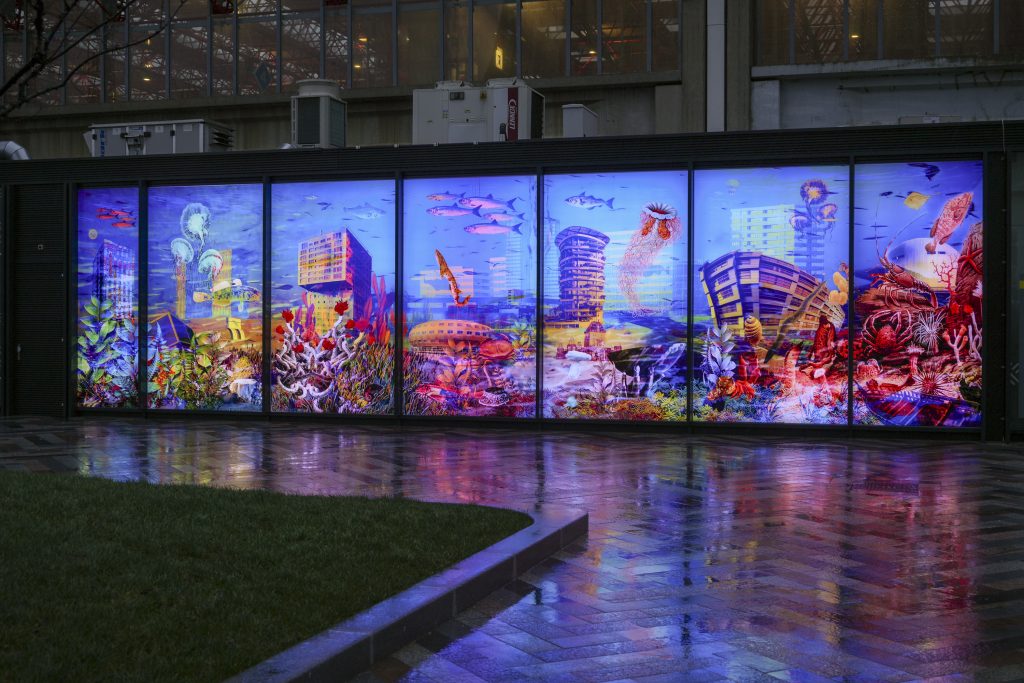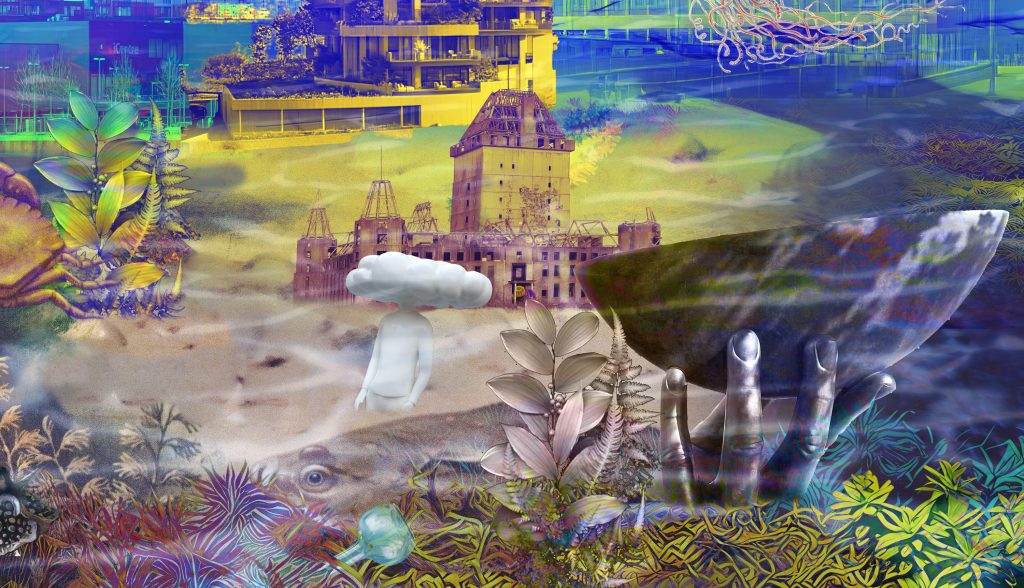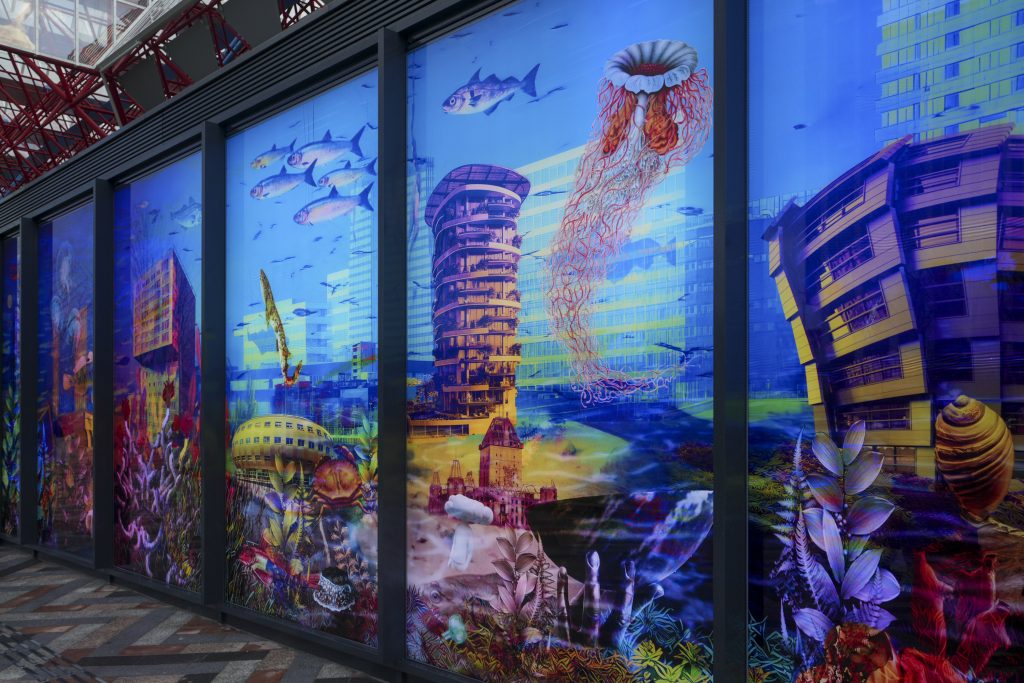Kunstwerk-Almere, Transparent print, glass, programmed Led light. 3.5 x 13 meters
Mandelaplein, Almere Central Station.
(English text below)
Almere is een stad die snel met water in verband wordt gebracht; gebouwd op ‘herwonnen’ land. De stad staat symbool voor het optimisme en de toekomstgerichtheid van het naoorlogse Nederland; Cultuur als overwinning op de Natuur.
Maar schadelijke gevolgen van klimaatverandering worden steeds meer zicht- en voelbaar. Klimaatwetenschappers en de vergruisde milieuactivisten uit de jaren 70 van de vorige eeuw hadden gelijk: de planeet heeft een beperking aan haar verdraagzaamheid voor de oorlog die we voeren tegen de natuur. Als we niet ophouden onze wereld te verdelen in cultuur en natuur, zullen we onszelf vernietigen.
Kunst geeft geen oplossingen, maar ook kunst in de openbare ruimte kan een extra dimensie toevoegen aan vaste patronen en een opening bieden aan een andere manier van ‘kijken’.
Het kunstwerk-Almere weerspiegelt de relatie tussen water en Almere. Zien we de zee waaruit Almere is gewonnen of een toekomstig Almere als Atlantis 2.0 ?
In het werk botsen verschillende stijlen en media; fotografie, illustraties uit de jaren dertig van de vorige eeuw, samples van publieke kunstwerken in Almere, schilderachtige elementen en digitale glitches. Het is niet vreemd voor een kunstenaar die is opgegroeid in de sample-cultuur van de jaren ’80 en het postmodernisme van de jaren ’90. En dus ook met ‘het einde van de geschiedenis’. Maar dan niet, zoals postmoderne denkers zoals Fukuyama zich dat hadden voorgesteld omdat er geen grote verbindende verhalen meer zijn. Het water dat stijgt en dreigt de geschiedenis letterlijk te beëindigen, is het nieuwe alles-verbindende verhaal geworden, en geeft de geschiedenis zo weer een universele continuïteit. De vraag is wel of dat verbondenheid is in de ondergang, of in het keren van het tij; die hervonden geschiedenis zou wel eens heel kortstondig kunnen zijn.
Kunstwerk-Almere zoekt nadrukkelijk een relatie met het vernieuwde stationsgebied. Het kunstwerk is gesynchroniseerd met de seizoenen: elke zonsopgang en zonsondergang kleurt het kunstwerk mee met de eerste en laatste kleuren van de dag. Anders dan de dagelijkse treinreiziger, die is gesynchroniseerd met de klok. Die reiziger ziet het kunstwerk in de winter om 08.00 uur nog slapen en om 17.00 uur alweer in rood licht uitdoven. Maar in de zomer ziet diezelfde reiziger het kunstwerk om 08:00 uur al in vol licht en kan er tot 23.00 uur liggend in het gras bij het kunstwerk ge-chilled worden. Hulpmiddelen daarbij gebruiken kan natuurlijk, maar het aldoor bewegende, meanderende en veranderende lichtkunstwerk heeft van zichzelf ook al een hallucinogene kwaliteit.
Geert Mul ‘Kunstwerk Almere’ 2023
Transparante print, gelamineerd tussen glas en geprogrammeerd ledlicht.
Mandelaplein, Station Almere,
Opdrachtgever: Gemeente Almere, tot stand gekomen in samenwerking met kunstorganisatie Mothership.
























Almere, a city intrinsically linked to water, embodies the essence of a nation shaped by its aquatic origins. It stands as a symbol of post-war hope and the triumph of culture over nature. Nevertheless, the pernicious impacts of climate change are increasingly evident and palpable. The prognostications of scientists and environmentalists from the 1970s hold true: there exists a threshold to the Earth’s tolerance for the conflict we wage against the natural world. Unless we abandon the division between culture and nature, we risk our own destruction.
Art doesn’t solve problems, but art can add an extra dimension to public space and offer a different way of “looking.” The Almere artwork reflects on the relationship between water and Almere. Do we look at the promoted past, Almere the city on reclaimed land, or at a future Almere; Atlantis 2.0?
Different styles and media collide in the work; photography, illustrations from the 1930s, samples of public artworks in Almere, picturesque elements and digital glitches. This is not surprising for an artist who grew up in the sample culture of the 1980s and the postmodernism of the 1990s. And so with “the end of history.” But then there is no end, as postmodern thinkers like Fukuyama had imagined because there are no longer any great connecting stories; The water that rises and threatens to end history literally has become the new all-connecting story, giving history a universal continuity. Whether that is a connectedness in the downfall or in the turning of the tide, may be a very short-lived, new history.
Kunstwerk-Almere expressly seeks a relationship with the renovated station area. It is synchronized with the seasons, changing color with the first and last daylight colors at every sunrise and sunset. Different from the daily train passengers who are synchronized with the clock. The traveler finds the artwork still sleeping at 08:00 in the winter and extinguishing in orange light again at 17:00 in the afternoon. However, in the summer, the same traveler can see the artwork in full light at 08:00 and can chill out in the grass by the artwork until 23:00 at night. During this time, people can use substances, but the ever-changing, meandering, and changing light-artwork has a hallucinogenic quality itself.
Client: Municipality of Almere, created in collaboration with art organization Mothership.